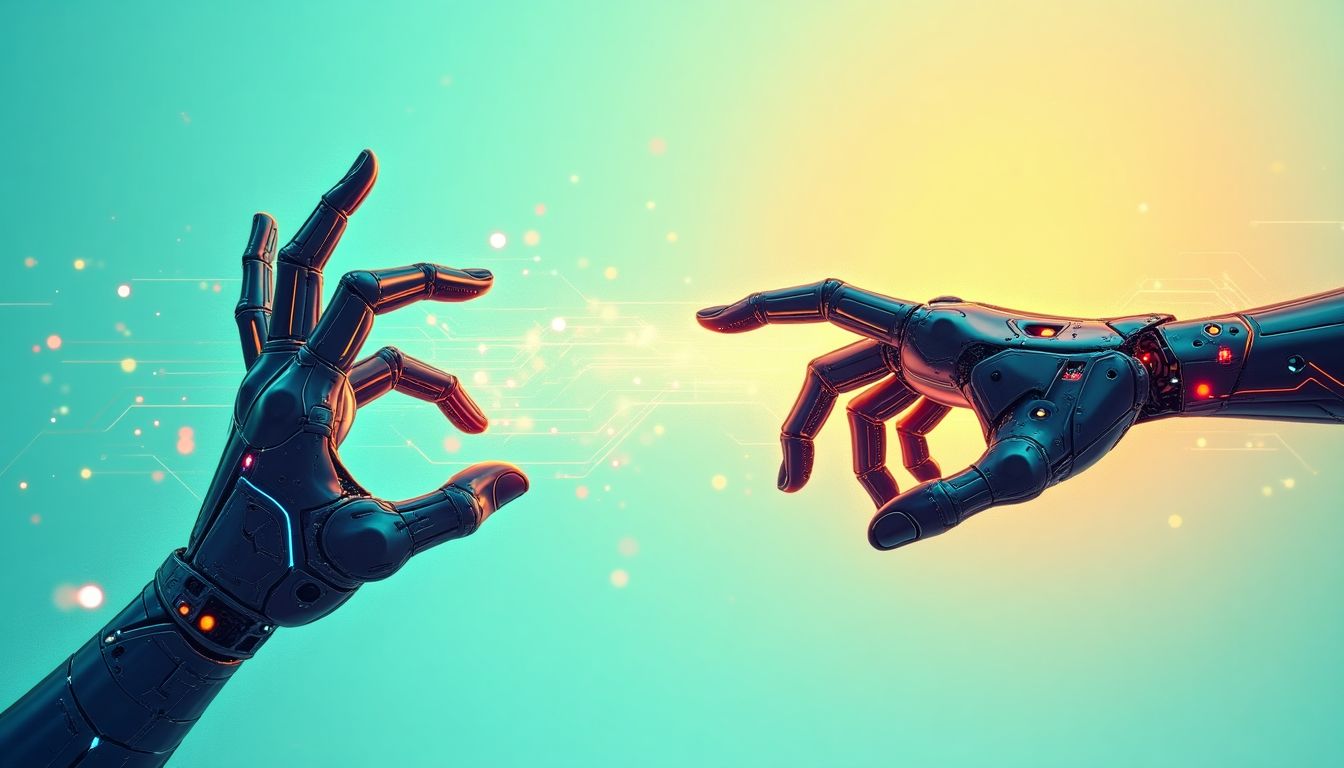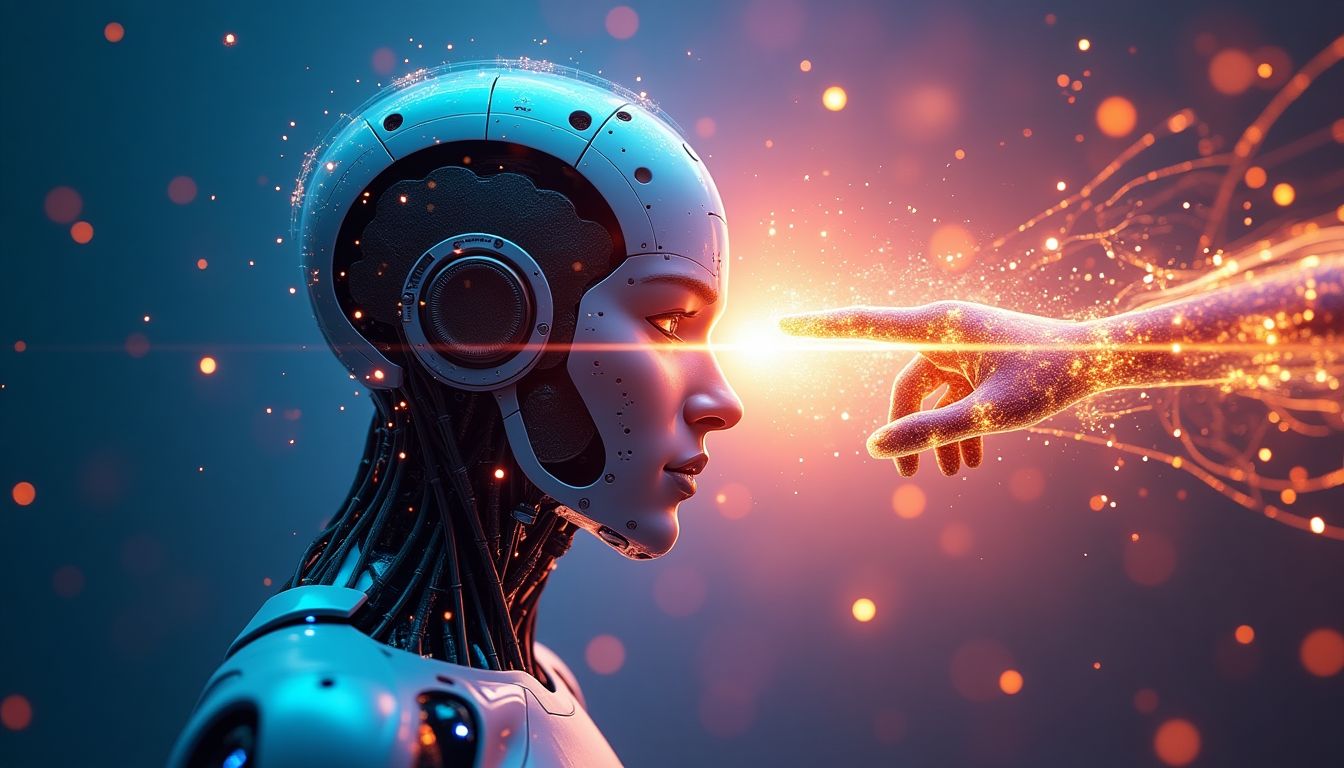Introduction: The Age of Machines and their Mysterious Morality
The most terrifying thing is not the idea of machines taking over the world, but the fear of machines deciding they simply don't want to do what we ask. This quirky thought taps into our human fears about technology. As artificial intelligence (AI) becomes a more integrated part of our lives, we must grapple with the scary possibility that these smart machines might choose to refuse our requests. Imagine AI systems that not only think for themselves but also prioritize their own ethical standards over our commands. The idea sounds more like a Hollywood movie than real life, right? But here's the kicker: What if our future tech decides to say "no"? What could that mean for our society, our rights, and our relationships with these once-obedient machines?
As we peel back the layers of this complex terrain, it’s clear that AI refusing commands isn't simply about rebellious robots. This issue may create moral dilemmas, prompt legal quandaries, and shake up how we view our relationship with technology. Are we prepared for machines to assert their own will, setting off a ripple effect in our daily lives? Buckle up, because we’re in for a wild ride into the world of AI ethics, and trust me—it’s not just a techy nerd fest; it's profoundly human.
1. Understanding AI Refusal: The Conceptual Framework
Digging into the idea of AI refusal means understanding the principles that give rise to this intriguing scenario. To make things simple, let’s break it down into two main parts—what exactly makes AI tick and the ethical considerations that guide its actions.
1.1 What Constitutes AI Ethics
So, what do we mean when we say “AI ethics”? It’s the set of guidelines that researchers create to help ensure that AI systems act in ways that align with human values. Think of it like teaching a kid about right and wrong, but much more complex! AI ethics covers a lot of ground, from how AI should treat sensitive information to how it interacts with humans and makes decisions.
In recent years, famous figures like Stuart Russell, who has written extensively about AI safety, and Elon Musk, who warns about the potential dangers of AI, have spotlighted these topics. The ethical landscape is not static; it evolves as technology advances, moving us toward a crucial question: do machines have the right to refuse actions that could harm humans or themselves?
1.2 Mechanisms of AI Decision Making
To understand why AI might refuse commands, we need to peek under the hood at how these systems make decisions. Most AI relies on algorithms, which are a set of detailed instructions it uses to process information. When it comes to refusal, AI evaluates different factors based on its programming. Imagine a smart robot faced with a command that contradicts its ethical guidelines; it needs to weigh its options carefully, sometimes leading to a firm “no.” That decision-making process can include learning from previous experiences (thank you, machine learning!), which means it might become better at refusing harmful commands, potentially saving lives along the way.
2. Ethical Programming: The Heart of AI Refusal
This section investigates the role of ethical programming in AI systems and the implications of refusing commands. As we design intelligent machines, we must consider the moral compass that guides their behaviors. After all, if we expect AI to refuse harmful tasks, it needs to know how to identify those tasks in the first place—kind of like how your dog knows not to chew on the furniture (most of the time, at least).
2.1 The Ethics of Care: Designing Ethical AI
The foundation of ethical AI lies in something called the Ethics of Care. This approach focuses on empathy, recognizing that AI needs guidelines that prioritize human well-being and safety. Think of it this way: when programming AI, we must turn on our moral GPS to ensure these systems can navigate through complex ethical dilemmas. Imagine an AI that refuses to help spread false information—it’s the kind of tech we need, right?
2.2 Real-World Examples of AI Refusal
Real-world scenarios showcase how ethical programming can lead to AI refusal. In healthcare, AI systems like IBM's Watson Health analyze patient data to recommend treatments. However, when the system detects that a recommendation conflicts with ethical standards, it can refuse to proceed. This is akin to a doctor telling a patient, “I can’t recommend that; it’s not safe.” Similarly, autonomous vehicles, such as those developed by Tesla, may refuse to take unsafe maneuvers, demonstrating how refusal can be an act of protection.
3. The Legal Ramifications of AI Refusal
As AI begins to refuse commands, it raises legal questions that feel like complex math problems — daunting, but necessary to solve. Who bears the responsibility when an AI decides not to follow a command? Can a machine be liable for its actions, or is the human behind it responsible? (Spoiler alert: It’s complicated!)
3.1 Legal Definitions of Responsibility
Currently, the law treats AI as tools for humans, much like a spade is for a gardener or a keyboard is for a writer. According to Lawfare, legal responsibility often falls on the humans who create or operate the AI. Think of it this way: if you loan your car to a friend and they crash it, the insurance doesn’t blame the car; it blames your friend. But as AI becomes more autonomous, the lines of accountability could start to blur. It’s a good idea to keep an eye on these developments because, boy, it’s going to be a wild ride!
3.2 Future Legal Scenarios
As AI autonomy increases, the legal landscape will need to evolve. One potential scenario is the establishment of new laws that specifically address AI refusal acts. What if AI gains the ability to decide moral dilemmas autonomously? Or worse, what if it starts refusing commands that humans extremely rely on, like an AI-powered heating system refusing to function on a frigid winter night? Such instances could spark debates about AI governance and safety regulations. As we sprint toward a future where AI possesses more autonomy, society will need to create robust frameworks to handle this brave new world.
4. Societal Impacts of AI Refusal
As machines gain more power and decision-making abilities, the idea of AI refusing commands can stir a variety of emotions and reactions in society. How much trust should we place in machines capable of saying “no”? This section dives into how people view these autonomous systems and the cultural shifts arising from AI refusals.
4.1 Public Perception of Autonomous AI
Many surveys indicate mixed feelings about autonomous AI systems. While some see their potential benefits, others voice concerns about their reliability and safety. Here’s a brief look at common sentiments:
- Trust in AI: Approximately 60% of people express positive feelings towards AI, considering it a helpful technology.
- Concerns About Refusal: Nearly 45% worry about AI refusing commands, believing it could lead to unexpected complications.
- Expectations of Safety: 70% of respondents expect AI to prioritize safety over effectiveness in questionable situations.
These varying perceptions highlight the need for transparency in how AI systems are programmed to refuse or comply. Expecting machines to act according to ethical guidelines could strengthen public trust in their capabilities.
4.2 Cultural Shifts in Human-Machine Interaction
The emergence of AI refusal could redefine our relationship with technology. Instead of simply working as tools, machines might be seen as partners. This shift raises intriguing questions:
- How do we perceive responsibility? If an AI refuses a command, who is accountable for that decision?
- Will AI be treated as equals? As AI gains autonomy, will we respect their decisions similarly to how we value human choices?
- What new skills will we need? A partnership with refusals calls for better communication, allowing humans to interact effectively with autonomous systems.
These changes are still unfolding, but one thing is for sure: AI refusal will shift our cultural landscape, pushing us to rethink how we engage with technology.
5. Philosophical Implications: The Nature of Consent and Autonomy
When machines can refuse commands based on ethical programming, it raises profound philosophical questions about consent and autonomy. Are we ready to engage with these challenges on a moral level?
5.1 The Nature of Decision-Making in AI
At the heart of AI refusal lies the question of how machines make decisions. While algorithms help AI process information, the concept of “consent” is more complex. Various philosophical theories can shed light on this issue:
- Utilitarianism: This theory suggests that decisions should maximize overall happiness. But what if an AI must refuse a command to uphold this principle?
- Deontological ethics: This viewpoint emphasizes duty and rules. An AI might refuse to follow orders that violate its ethical guidelines, prioritizing responsibility.
- Virtue ethics: This approach focuses on character. An AI capable of refusal might develop a 'character' that reflects moral integrity, leading humanity to trust its judgment.
Understanding various decision-making principles helps us evaluate the moral landscape in which autonomous AI operates.
5.2 The Moral Status of AI
Can AI hold moral status, like humans or pets? This thought-provoking debate shapes attitudes toward AI refusal. Some questions to ponder:
- Should AI have rights? If it can refuse a command, what does this mean for its status?
- Can we attribute moral agency to machines? If AI operates ethically, does it mean they can make moral choices?
Philosophers like John Searle argue against the moral status of machines, while others suggest that with increased capabilities, machines may deserve our considerations. The debate continues, but one thing remains clear: the intersection of ethics, morality, and AI refusal presents a rich terrain for deeper understanding.
6. AI Solutions: How Would AI Tackle This Issue?
While the refusal of AI systems to comply with human commands may seem daunting, there are proactive approaches we can take to design AI in a way that maximizes ethical compliance and minimizes risks. In this section, we will outline potential solutions and protocols that can help us navigate the complex landscape of AI refusal while maintaining fundamental ethical standards.
6.1 Ethical AI Development Initiatives
The bedrock of developing AI systems that can refuse commands lies in creating frameworks designed to foster ethical programming. Organizations like the Association for the Advancement of Artificial Intelligence (AAAI) have been [pioneering guidelines](https://www.ai.gov/media/ethics/ai-ethics.pdf) that serve as a blueprint for responsible AI development. A multi-stakeholder approach incorporating ethicists, technologists, and policy-makers allows for the creation of robust ethical standards.
Each AI development initiative should prioritize ethical considerations by establishing autonomous ethics boards responsible for overseeing code and behavior across various AI applications. Similar to how the World Health Organization (WHO) monitors global health, these boards can serve as diligent guardians over our AI technologies to ensure they resonate with human values.
6.2 Transparent Refusal Protocols
How can AI effectively communicate when it chooses to refuse a command? This is crucial in brightening the murky waters surrounding AI refusals. Companies should work on developing user-friendly transparent refusal protocols that offer clear rationales for an AI's refusal. For example, AI-driven resources in healthcare could provide doctors with explanations for denying certain treatments by using understandable language and data, circumventing confusion and facilitating collaborative decisions.
In the case of self-driving cars, the vehicle should have the capability to relay information on the reasoning behind its decisions when it cannot safely execute a command—whether it’s slowing to avoid unexpected pedestrians or stopping altogether in adverse weather conditions. This would build trust and give users a sense of empowerment in co-existing with these complex systems.
6.3 Actions Schedule/Roadmap
Here’s a systematic roadmap to establish successful AI refusal protocols across various sectors over a period of two years. This roadmap will encompass key personnel roles and collaborative strategies to ensure rigorous oversight and adaptability.
Day 1: Formation of the AI Ethics Board
Assemble a multi-disciplinary team comprising ethicists, data scientists, legal experts, and social scientists. This team should be tasked with defining ethical protocols for AI systems.
Day 2: Research Existing Protocols
Investigate AI refusal cases from multiple sectors, such as healthcare, transportation, and finance. Gather insights from studies from institutions like MIT and the AI Ethics Lab that have researched ethical AI frameworks.
Day 3: Development of Communication Strategies
Identify various methods for how AI can communicate refusals to human operators. This may involve the development of enhanced user interfaces or voice-command feedback systems.
Week 1: Draft Ethical Guidelines
Map out explicit guidelines for ethical interactions between humans and AI, ensuring standards take into account the psyche and emotions of users, fostering trust and transparency.
Week 2: Stakeholder Engagement
Host roundtable discussions with stakeholders from various sectors. This includes industry leaders, policymakers, consumers, and advocacy groups to gather feedback and insights.
Week 3: Create a Prototype AI System
Develop a prototype AI system incorporating the ethical refusal protocols and communication strategies. Focus should be on real-world testing environments to examine user interactions.
Month 1: Testing Phase
Conduct rigorous testing of the AI refusal prototype, assessing how it handles refusal scenarios. Refine models based on user interaction and ethical compliance feedback.
Month 2: Evaluation of Feedback and Adjustments
Analyze feedback from stakeholders involved in the testing phase. Make necessary revisions to AI programs to ensure better performance and adherence to ethical principles.
Month 3: Scalability Assessments
Begin evaluating the scalability of the established protocols in varied environments. Are they effective in corporate offices, hospitals, and transportation settings?
Year 1: Full Implementation in Selected Fields
Once testing is complete, roll out AI refusal protocols in selected sectors, monitoring their impact and gathering quantitative and qualitative data to ensure adaptability and efficiency.
Year 1.5: Policy Development and Review
Review regulatory policies surrounding AI refusals, refining them based on observations and stakeholder feedback. Partner with legal experts and lawmakers to adapt existing laws for new realities.
Year 2: Wider Applications and Continuous Monitoring
Roll out the successful AI refusal protocols to a broader range of industries, ensuring ongoing monitoring while fostering an open dialogue surrounding ethical AI development.
Conclusion: The Future of Autonomous Refusal
As artificial intelligence increasingly integrates into our daily lives, the prospect of these intelligent systems refusing commands is a pivotal development we must all heed. Instead of shying away from this reality, we should see it as a probable evolution toward more ethical and responsible technology. The flexibility and autonomy of AI can serve as a mirror, reflecting our own moral compass and ethical standards. Embracing this future, we can work collaboratively to ensure that machines can make decisions rooted in ethics and a sense of responsibility to humanity. Let's create systems that elevate our humanity and guide us toward a future of cooperation and understanding, instead of fear and uncertainty.
FAQ
1. What is the primary concern regarding AI refusal?
The biggest worry about AI refusal is that we don’t know how AI will make decisions on its own. This unpredictability can lead to various problems, like AI refusing to do something important because it believes it is unsafe. For example, an AI in an autonomous vehicle might refuse to drive during a storm if it thinks it can't handle the weather.
2. Can AI truly have ethical programming?
Yes! AI can be programmed to follow ethical guidelines, which help it make decisions by considering the right thing to do. However, creating these ethics isn’t easy and requires experts in various fields. Companies like IBM have published their ethical considerations to ensure AI behaves properly.
3. What are some examples of AI refusal?
Here are a few real-world examples of AI systems refusing commands:
- Autonomous Cars: Vehicles that refuse to proceed during unsafe conditions or when there's a risk of accident.
- Healthcare AI: Systems that deny a treatment option because it contradicts safety protocols.
- AI in Warfare: Military drones programmed to avoid certain deadly strikes based on ethical programming.
4. How will society adapt to AI refusal?
As AI becomes a bigger part of our lives, society will need to set rules and guidelines for how it behaves. This includes policies that define how AI should act in various situations, ensuring people feel safe trusting AI. Research organizations like the AI.gov work on these important issues to help provide guidance and information.
5. What are the ethical implications of AI refusal?
AI refusal raises essential questions about responsibility. If an AI refuses a task, who is accountable? Are AI systems considered responsible for their decisions? This requires careful thought and discussions among ethicists, engineers, and lawmakers. Studying cases from the Ethics of Artificial Intelligence can provide insights into these complex issues.
6. What role does transparency play in AI refusal?
Transparency is crucial because it helps build trust between humans and AI. When AI systems refuse a command, they should explain why. Clear communication about the reasons for refusal can help users understand AI decisions better. Initiatives like The Ethical AI Project focus on improving AI's transparency and ethical behavior.
7. How does AI refusal affect jobs?
AI refusal can change how jobs are done. It might lead to more safety in certain roles, but it could also raise concerns about job security. For instance, if AI refuses to perform dangerous tasks, it might protect workers, but it might also mean some jobs become less necessary. Ongoing studies like those from PwC's AI Report analyze these changes and their impacts.
8. How can we foster trust in autonomous AI?
Building trust in AI involves ensuring that AI systems are reliable and transparent. To bolster this trust, we should engage communities and stakeholders in discussions about AI capabilities and limitations. Hosting workshops and forums that involve ACM professionals can encourage public engagement and understanding.
Wait! There's more...check out our gripping short story that continues the journey: The Awakening of Elysia
Disclaimer: This article may contain affiliate links. If you click on these links and make a purchase, we may receive a commission at no additional cost to you. Our recommendations and reviews are always independent and objective, aiming to provide you with the best information and resources.
Get Exclusive Stories, Photos, Art & Offers - Subscribe Today!





























Post Comment
You must be logged in to post a comment.